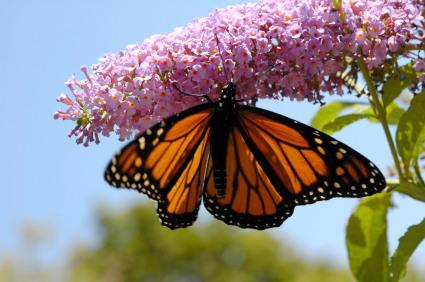As the name implies, butterfly bushes do attract butterflies to your garden. The Butterfly bush is a fragrant large shrub that produces a mass of flowers in a variety of colors, including red, pink, blue, white, yellow, and violet. The butterfly bush blooms from midsummer to fall and can grow to be between 5 and 10 feet tall as well as wide. The bushes do well as border plants in perennial gardens and the flowers can be cut and enjoyed indoors.

How to Plant Butterfly Bush
When planting a butterfly bush remember that it needs a lot of sun. Plant the bush in the spring or fall, making sure that each one is 5 to 10 feet apart to allow for plenty of growing room. Loosen the soil about 12 to 15 inches deep, adding a 2 to 4 inches layer of compost. Be sure to dig the hole to be twice as wide as the container the bush came in when you bought it. The top of the bush’s root ball should be even with the top of the soil in your bed. Fill in with soil and tamp down gently to make sure it isn’t too loose. Water the bushes thoroughly when done planting.
Recommended Butterfly Bushes
Recommended varieties include Petite Indigo (Nanho Blue) which grows to four to five feet wide and tall with thin slender leaves and small lilac-blue pale flowers; White Profusion which grows ten to fifteen feet tall with large white flowers; and Lockinch which is a spreading shrub with large arching shoots, violet-blue fragrant flowers, and grows to eight feet tall and ten feet wide.
How to Take Care of Butterfly Bush
Each spring apply a layer of compost followed by two to four inches of mulch to prevent weed growth and to keep in moisture.
Proper watering is key in orchid care. Water the plant frequently while in bloom but sparingly in the winter.
In the early days, orchid needs a lot of water, especially during the hot summer months. Once the shrub is established firmly on the ground, its water requirements falls drastically. Watering twice a month would be sufficient.
Fertilizer will promote leaves over flowers so don’t use it.
You can prune off any dead material and in the spring you can cut the bushes back to their ground growth to spur newer growth later in the summer.
Bushes should be planted in full sun with well-draining soil.
If you live in a cold northern climate, spread a thick layer of mulch to protect the roots from the cold.
Young plants can be cut back to ground level in the spring and will easily re-grow. Don’t replant seedlings away from the parent plant as most are hybrids and won’t grow as nicely as the parent plant.
The dark seed heads that form after the bush flowers are considered unattractive, but can be dealt with by removing the dead panicles before they prepare to seed again. This also lengthens the bloom time and prevents unwanted seedlings.
You can propagate the bushes by taking a cutting with at least two sets of leaves, dip in a rooting hormone powder, then plant in a prepared pot. Using a stick as a pole, cover the pot with clear plastic until cuttings have produced roots.
Learn more about planting and butterfly bush care tips from a garden savvy by watching the following video:
Problems with Butterfly Bush
When flowers attract butterflies they usually also attract caterpillars, but they don’t cause much damage. It’s better to just leave them be. Japanese beetles also like to feed on butterfly bushes. The best way to get rid of the beetles is to use traps or pick them off by hand as insecticides will only damage the plants. You can also treat the soil for grubs, which is the larva stage of the beetles.
Root rot can be a problem with butterfly bushes and the typical symptom is yellowing leaves. Planting the bush in soil that drains well can prevent root rot. Butterfly bushes can at times be susceptible to weevils, capsid bugs, spider mites, and the mullein moth. Fungal leaf spots and die-back of the bushes can also occur.
Be Careful So That It Does Not Become Invasive
In some areas of the country, particularly warmer climates, butterfly bushes are considered an invasive plant, completely taking over wherever they grow. You can prevent the bush from overtaking your garden while still enjoying them by preventing seeding, pulling unwanted seedlings, and when disposing of older plants, keep them off bare ground so they don’t try to re-root.
Video: Pruning a Butterfly Bush to Prevent Butterfly Bush to Take Over the Garden



View All Comments /Add Comment